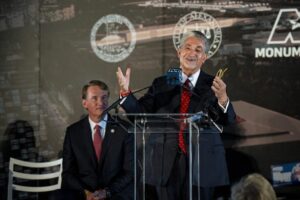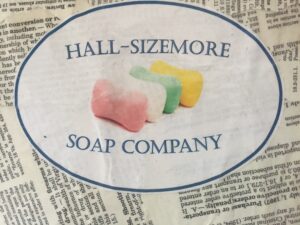
by Dick Hall-Sizemore
If approved by the General Assembly and the City of Alexandria, the deal reached between Gov. Glenn Youngkin and the owner of the Washington Wizards and the Washington Capitals for those teams to move from Washington, D.C. to the Potomac Yards site in Alexandria would constitute the largest public subsidy for a sports team in the nation’s history. That is the conclusion of a report by JP Morgan commissioned by the state, a copy of which was obtained by The Washington Post.
The total estimated cost of the project is $2.2 billion. The owner of the sports teams, Monumental Sports and Entertainment would contribute $403 million up front. The City of Alexandria would be on the hook for $106 million.
The state would create a sports and entertainment authority which would own the land and the buildings and lease them to Monumental. The company would sign a 40-year lease with rent beginning at $29.5 million annually and increasing to $34.5 million. In addition to the arena for the two sports teams, the project would include a concert hall, underground parking, a conference center, a Wizards practice center, and Monumental’s corporate offices and media station.
To get the cash to construct these facilities, the authority would issue two sets of revenue bonds. The first batch, for $1.05 billion, would be repaid with tax receipts, parking revenue, and the proceeds from the sale of naming rights. The second set of bonds, $416 million, would be repaid from lease payments from Monumental. According to the Post, two Youngkin aides said that the tax revenue would come from “income taxes on players, executives and workers at the site, plus business, sales, ticket and hotel tax revenue generated only from the first phase of the development.”
Finally, there will be up to $200 million in transportation revenue “redirected” to this project. The details have not been worked out (or made public) but are thought to include improvements to Glebe Road and Rt. 1 in Alexandria, as well as a major enlargement of the Metro station just opened at the site last May.
My Soapbox
I thought Republicans were big proponents of private property and opponents of big government. Government should get out of the way of business. “What the government does, the private sector can do better and cheaper,” a major aide to Gov. George Allen once pointedly told me in a meeting.
Enabling a multi-billionaire to take advantage of more than $1 billion in tax-exempt financing is a major subsidy, no matter how you look at it.
First, the governor claimed, “There is no upfront investment or inclusion of any taxes already being collected by the Commonwealth to repay the bonds and there will be no tax increase for local residents.” He conveniently forgot about the $200 million in transportation funds being “redirected” to the project. “There’s sort of an asterisk,” one Virginia official explained, speaking anonymously. “That didn’t come across clearly.”
More importantly, the governor justifies this “quintessential public-private partnership” on the grounds it “takes revenues that otherwise would not exist and uses those as underpinning to support the project.” That is the argument used by Richmond Mayor Levar Stoney in pushing for the Navy Hill project, which fell apart after the media, independent analysts, and the city council dug into the details of the funding proposal.
Furthermore, this argument that these are revenues that would not exist is disingenuous at best. This is a prime piece of land, owned by one of the largest real estate developers in the region, if not the nation, JGB Smith. It sits adjacent to the site of the Virginia Tech Innovation Campus. The first building of the campus will open in the fall of 2024. Two more buildings are planned. When complete, Tech projects that the campus will be home to “750 master’s and 200 doctoral students and will graduate 550 master’s and 50 doctoral candidates annually.” It is entirely reasonable to expect that national high-tech companies would want to build facilities next door to take advantage of this talent. In fact, Youngkin touted the ability of the Innovation Center and Monumental, being next-door neighbors, to develop partnerships for entrepreneurship, sports analytics, immersive technologies, business and media. In other words, the state not only subsidizes the building of a sports arena complex and headquarters for the company, it trains its high-tech workforce, as well. Why not have other high-tech companies, who would be providing tax revenue to the state and locality, locate here and take advantage of the Innovation Center?
Finally, Younkin himself admitted the fallacy of the argument that these revenues would not “otherwise exist.” In defending the redirection of transportation revenue he said, “We know we’re going to have work to do on Glebe Road, we know we are going to need improvements along Route 1, and interchanges. We’re going to have bike paths, we’re going to have buses and we know all of this is going to be done over the course of time….We always knew something else was going to go here.” [Emphasis added.]

Leave a Reply
You must be logged in to post a comment.